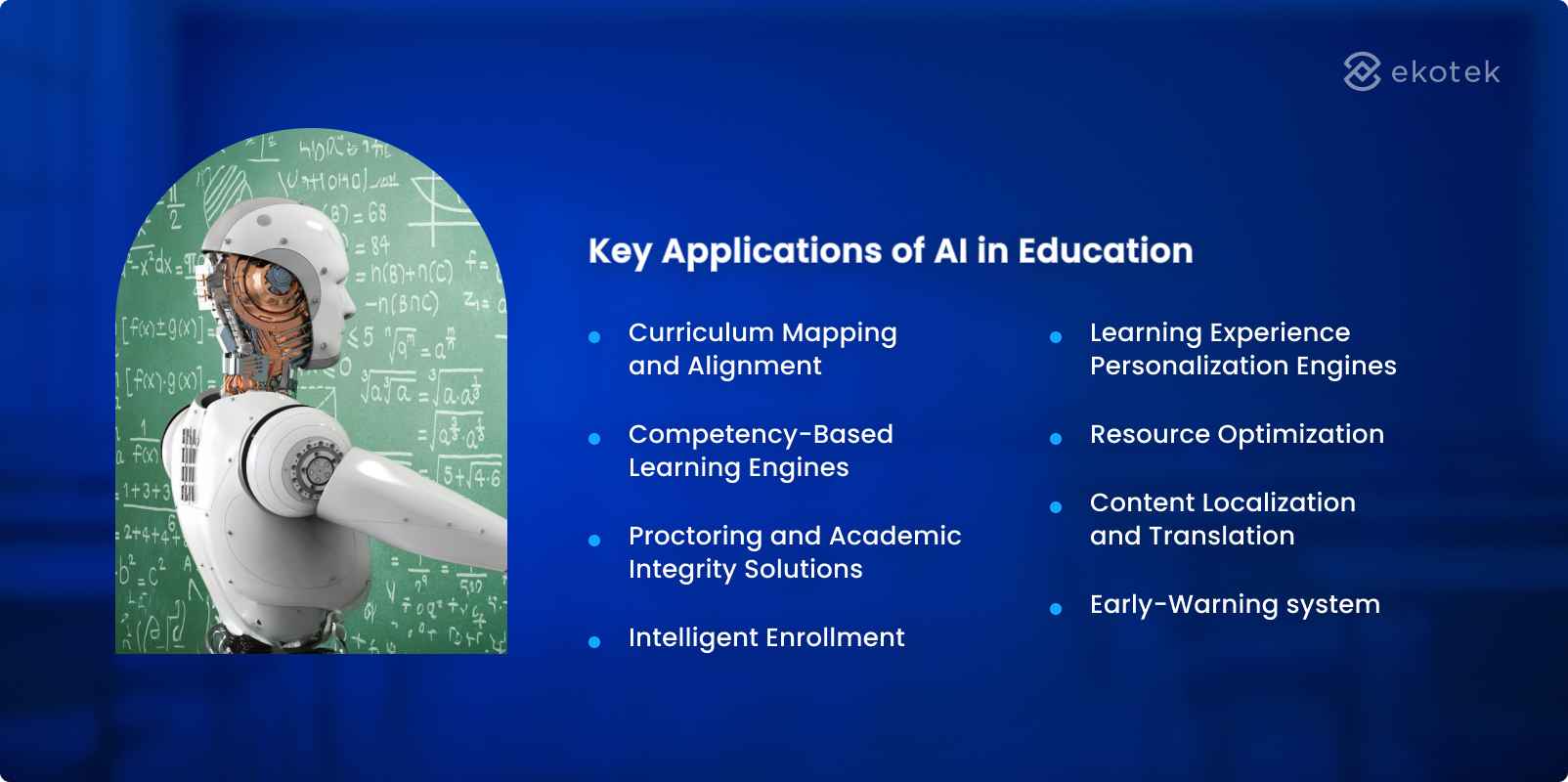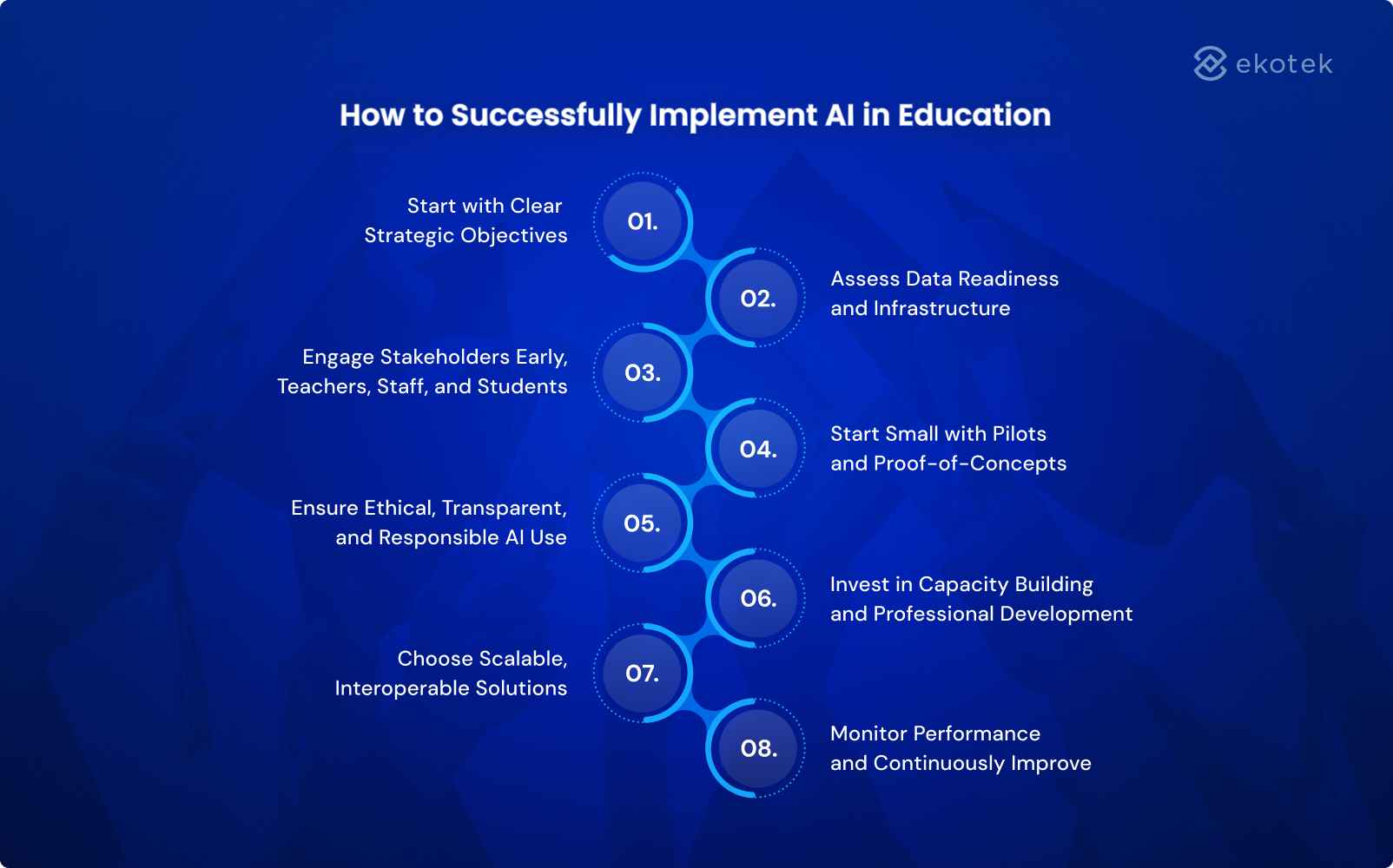
- 1
- 2
- 3
- 4
- 5
- 6
- 7
- 8
- 9
Introduction
The rapid evolution of AI in education is reshaping how institutions deliver learning, measure performance, and scale their impact. For leaders and decision-makers, AI is no longer just a technological upgrade, it is a strategic tool that drives operational efficiency, enhances learner outcomes, and strengthens long-term competitiveness. As organizations face increasing demands for personalization, automation, and data-driven decision-making, AI offers a clear pathway to modernize training, streamline administration, and build future-ready education ecosystems.
The Current State of Education and Emerging Challenges
The education sector worldwide faces mounting challenges that impede effective learning and management. The growing pressures of digital transformation necessitate scalable solutions and robust e-learning platforms capable of meeting diverse learner needs.
Global clients, including universities and corporate organizations, are partnering with technology providers to address these pain points, which commonly include:
- Personalization of learning experiences to cater to individual needs
- Limited access to quality educational resources
- Ensuring consistency and quality standards across platforms
- Maintaining data security and privacy in digital tools
These challenges are accelerating the adoption of AI-driven technologies that promise to reshape education fundamentally.
Benefits of AI in Education
For Students
-
Personalized learning pathways that adapt to each student’s pace, strengths, and skill gaps.
-
Real-time feedback and support through intelligent tutoring systems that enhance comprehension and motivation.
-
Greater accessibility with AI tools such as automated transcription, translation, and learning support for students with disabilities.
-
Improved engagement via interactive, immersive AI-driven simulations and gamified learning experiences.
-
Enhanced self-management through AI-powered progress tracking and learning recommendations that help students take ownership of their learning.
For Teachers
-
Reduced administrative workload by automating grading, attendance, lesson planning, and content creation.
-
Data-driven insights to help identify struggling learners early and design targeted interventions.
-
Improved classroom management through predictive analytics that highlight behavior or performance trends.
-
Continuous professional development with AI recommending new teaching strategies based on performance and classroom data.
-
Higher teaching efficiency and focus, allowing educators to dedicate more time to mentoring, coaching, and innovation rather than paperwork.
For Policy Makers
-
Evidence-based decision making using real-time, aggregated data on learning outcomes, skill gaps, and institutional performance.
-
Optimized resource allocation through AI-driven forecasting models that predict enrollment, workforce needs, and funding priorities.
-
Improved national education planning with AI identifying long-term trends in student performance and labor market demands.
-
Enhanced monitoring and evaluation systems that track policy impact at scale with greater accuracy and transparency.
-
Support for inclusive and equitable education by using AI to identify underserved communities and target interventions effectively.
📌 See how Ekotek’s partnership with PTIT drives Vietnam digital transformation
Key Applications of AI in Education
 Curriculum Mapping and Alignment
Curriculum Mapping and Alignment
AI analyzes learning standards, industry skill requirements, and existing course materials to automatically map, align, and update curricula. This helps institutions maintain program relevance and respond quickly to changing workforce demands.
📌 Read more about Generative AI In Digital Transformation
Competency-Based Learning Engines
AI systems identify granular competencies, tag learning resources accordingly, and guide learners through mastery-based pathways. This enables institutions to shift from time-based models to skill-based progression frameworks.
Proctoring and Academic Integrity Solutions
AI-powered remote proctoring tools monitor test-taking environments, detect anomalies, and flag suspicious behavior. These systems help institutions maintain integrity in online assessments while scaling remote programs globally.
Intelligent Enrollment and Recruitment Systems
AI predicts applicant success, segments prospects, and personalizes outreach campaigns. Institutions can optimize recruitment pipelines, improve conversion rates, and tailor enrollment strategies for different markets.
Learning Experience Personalization Engines
Rather than just adapting difficulty levels, AI orchestrates the entire learning experience, recommending modules, formats (video, simulation, reading), schedules, and learning modes based on behavioral patterns.
Resource Optimization and Infrastructure Planning
AI models forecast classroom usage, staffing needs, budget patterns, and technology requirements. This enables leaders to plan campus operations more efficiently and support strategic expansion.
AI-Enhanced Content Localization and Translation
AI supports large-scale localization of digital learning content for global or multicultural markets. It automatically translates, adapts cultural references, and adjusts examples to local contexts, critical for cross-border programs.
📌 Explore how Ekotek built an AI solution that summarizes and translates news instantly
Early-Warning and Compliance Monitoring Systems
Beyond student performance, AI monitors institutional metrics such as accreditation standards, reporting requirements, and program-level KPIs, helping administrators ensure regulatory compliance and quality assurance.
How to Successfully Implement AI in Education
 Start with Clear Strategic Objectives
Start with Clear Strategic Objectives
Before adopting any AI tool, institutions must define what they want to achieve, improving learner outcomes, reducing operational costs, scaling programs, or modernizing curricula. Clear goals guide technology selection, budgeting, and performance measurement.
Assess Data Readiness and Infrastructure
AI systems rely heavily on high-quality, well-structured data. Organizations should evaluate their current data landscape, integrate student information systems, ensure data standardization, and invest in secure cloud infrastructure before deploying large-scale AI solutions.
Engage Stakeholders Early, Teachers, Staff, and Students
Successful implementation requires buy-in from those who will use AI daily. Leaders should involve teachers in pilot planning, gather student feedback, and provide training for administrative staff. Early engagement reduces resistance and accelerates adoption.
Start Small with Pilots and Proof-of-Concepts
Launching AI across the entire institution at once can be risky. Instead, run controlled pilots, such as AI-based tutoring, automated grading, or predictive analytics, measure impact, and refine the strategy. This approach limits risk and builds internal confidence.
Ensure Ethical, Transparent, and Responsible AI Use
AI in education must prioritize fairness, privacy, and data protection. Institutions should establish AI governance policies, clarify how data is used, conduct bias audits, and ensure transparency to maintain trust with students, parents, and staff.
Invest in Capacity Building and Professional Development
Teachers and administrators need ongoing training to effectively use AI tools. Institutions should offer workshops, certification programs, and hands-on practice to help staff integrate AI into instruction, curriculum planning, and operational workflows.
Choose Scalable, Interoperable Solutions
Technology should integrate smoothly with existing systems such as LMS, SIS, HR platforms, and analytics dashboards. Scalable, API-friendly solutions reduce technical friction and support long-term growth as AI adoption expands.
Monitor Performance and Continuously Improve
AI implementation is not a one-time project. Institutions should regularly evaluate outcomes, learning gains, cost savings, efficiency improvements, and adjust strategies accordingly. Continuous monitoring helps maintain relevance and maximize ROI.
📌 Unlock on-demand AI talent with AI outsourcing
Real-World Examples of AI in Education
Duolingo – AI for Personalized Language Learning
Duolingo uses AI to personalize lesson difficulty, analyze pronunciation, and adapt learning paths based on user behavior. Its “Birdbrain” AI engine is a well-known adaptive learning model used by millions of learners worldwide.
Khan Academy – Khanmigo as an AI Teaching Assistant
Khan Academy introduced Khanmigo, an AI-powered learning assistant that helps students ask better questions, solve problems, and explore concepts interactively. Teachers also use it to generate exercises, create lesson prompts, and monitor class progress.
Coursera – AI for Scalable Assessment and Content Creation
Coursera integrates AI to support large-scale grading and generate personalized quizzes and learning prompts. This enables instructors to manage massive online courses more efficiently while improving learner feedback cycles.
Georgia State University – Predictive Analytics for Student Success
Georgia State University is recognized for applying AI-driven predictive analytics to monitor student behavior and identify early signs of academic risk. Advisors use these insights to intervene proactively and support student retention.
📌 Want to build a similar AI solution? Connect with Ekotek’s AI development experts now
Future Trends: AI, Education, and Lifelong Learning
Fully Personalized, Competency-Based Learning
AI is transitioning education from standardized instruction to highly individualized pathways.
Institutions will increasingly use AI to:
-
map learner competencies in real time,
-
deliver adaptive content,
-
guide progression based on mastery instead of rigid schedules.
This trend directly impacts program quality, learner outcomes, and long-term competitiveness for education providers.
AI as a Co-Instructor and Workforce Amplifier
AI will move beyond simple automation into an active instructional partner, supporting content creation, facilitating discussions, summarizing lessons, and offering targeted learning support.
For institutions, this means:
-
increased teaching capacity,
-
reduced instructor workload,
-
greater scalability across large or distributed learner populations.
Integrated Data and Predictive Intelligence for Institutional Decision-Making
AI-driven analytics platforms will become core to strategic operations. They will provide:
-
predictive insights on enrollment, retention, and skills demand,
-
better resource planning,
-
improved policy and program design.
This empowers leaders to make faster, evidence-based decisions and maintain long-term sustainability.
Conclusion: Strategic Recommendations and Next Steps
AI in Education is redefining how institutions personalize learning, automate operations, and make data-driven decisions. The most impactful innovations, adaptive learning, AI co-instructors, and predictive analytics, are positioning education systems for greater scalability and long-term resilience. Organizations that embrace AI early will be better equipped to deliver high-quality learning experiences and meet evolving workforce demands.
As a trusted partner in AI development, Ekotek supports institutions and enterprises in turning these opportunities into reality. Our experienced AI team has delivered 450+ projects across education, manufacturing, finance, banking, and more. We offer a comprehensive portfolio of services, including AI consulting, AI integration, AI chatbots, generative AI, agentic AI, and computer vision, all built with rapid development cycles, strict quality assurance, and ongoing customer support. With Ekotek, organizations can innovate confidently and scale AI solutions sustainably.
FAQ on AI in education
1. How can AI in Education improve organizational efficiency?
AI automates tasks such as grading, scheduling, reporting, and student support, allowing institutions to reduce operational costs, streamline workflows, and reallocate staff toward higher-value activities.
2. Is AI difficult to integrate with existing learning or administrative systems?
With the right implementation partner, AI can be integrated smoothly through APIs and modular solutions. Most modern LMS, SIS, and ERP platforms support AI add-ons without requiring major infrastructure changes.
3. What ROI can education institutions expect from adopting AI?
ROI typically comes from improved learner outcomes, higher retention rates, reduced administrative workload, faster content development, and better decision-making through predictive analytics. Results vary based on strategy and implementation scale.
4. How can institutions ensure responsible and ethical use of AI?
Organizations should adopt clear governance frameworks, prioritize data privacy, conduct bias assessments, and maintain transparency with stakeholders. Working with experienced AI providers also ensures compliance with best practices and regulatory standards.
- 1
- 2
- 3
- 4
- 5
- 6
- 7
- 8
- 9